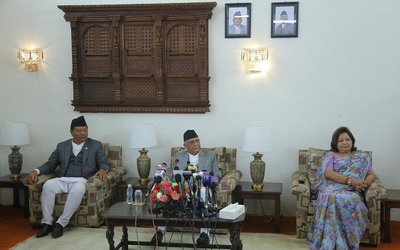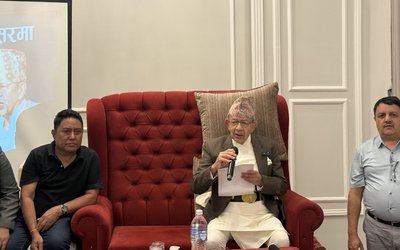Warming of the global climate is unequivocal, and primarily caused by increasing concentrations of Green House Gases (GHGs) produced by human activities such as the combustion of fossil fuels, and deforestation. A Recent Reports (IPCC, 2013) revealed that concentrations of CO2, CH4, and N2O have now substantially exceeded the highest concentrations recorded during the past 800,000 years. Despite the fact that its share in GHGs emissions is negligible (0.025 % of global emissions) compared to the global emissions, Nepal is hit hard disproportionately by the impact of climate warming compared to its size and contribution to the GHGs emissions. The impact may even be worse because of the fact that it lies between world's emerging and two of the largest economies (India and China) in the world. Warming of climate system including rise in surface temperature, erratic rainfalls, frequent increase in the extreme events such as drought and floods are some of the effects Nepal is experiencing in the past several decades, similar to what rest of the world is experiencing. Below has a glimpse of what is going in the world in terms of global climate change and its impact in Nepalese context.
The Intergovernmental Panel on Climate Change (IPCC) has released its Draft Report on “Climate Change 2013: The Physical Science Basis". A total of 209 Lead Authors and 50 Review Editors from 39 countries and more than 600 Contributing Authors from 32 countries contributed to this report. The Report revealed that “Warming of the climate system is unequivocal, and since the 1950s, many of the observed changes are unprecedented over decades to millennia. The atmosphere and ocean have warmed, the amounts of snow and ice have diminished, sea level has risen, and the concentrations of greenhouse gases have increased”. The Report further says that “The globally averaged combined land and ocean surface temperature data as calculated by a linear trend show a warming of 0.85 °C over the period 1880–2012. The total increase between the average of the 1850–1900 periods and the 2003–2012 periods was 0.78 °C. On a global scale, the ocean warming is largest near the surface, and the upper 75 m warmed by 0.11 °C per decade over the periods 1971–2010. Each of the last three decades has been successively warmer at the Earth’s surface than any preceding decade since 1850 and in the Northern Hemisphere, 1983–2012 was likely the warmest 30-year period of the last 1400 years". It has been projected that over the period 1901–2010, global mean sea level rose by 0.19 m. It has been observed in the last two decades that the Greenland and Antarctic ice sheets have been losing mass, glaciers have continued to shrink worldwide, and Arctic sea ice and Northern Hemisphere spring snow cover have continued to decrease because of the climate warming.
By now it is clear that human influence has been the dominant case of warming of the atmosphere and the ocean, changes in the global water cycle, reductions in snow and ice, global mean sea level rise, and changes in climate (IPCC, 2013). This is evident from increasing greenhouse gas concentrations in the atmosphere, positive radiative forcing, observed warming, and understanding of the climate systems. Radiative Forcing (RF) is the difference of radiant energy (watts/m2 of earth's surface) received by the earth and energy radiated back to space (A positive forcing warms the system, while negative forcing cools it). Causes of radiative forcing include changes in incident solar radiation and the concentration of radiatively active greenhouse gases including CO2 and aerosols. IPCC's 5th Assessment Report concludes that ccontinued emissions of greenhouse gases will cause further warming and changes in the Earth's climate system. In order to limit this warming trend, it will require substantial and sustained reductions of greenhouse gas emissions from current level.
Potential Implications of Climate Warming in Nepal
There has been very little done to understand the impacts of climate change in Nepal. The climate analysis done so far is largely based on literature review and some preliminary scattered information. As such, no long-term planning to collect long-term data to understand the complexity of the climate system. Climate change mitigation and adaptation are too far from the government's radar until now. However, some regional organizations such as ICIMOD have started seriously looking in these issues, despite the lack of data for climate modeling.
Variation in climate system has serious implications for our ecology, physical, economic, health, and agriculture system and to the population. Synnott (2012) stated that the temperature in Nepal is rising at a rate higher than the global average, with a 1.8°C increase between 1975 and 2006.Climate warming has already started threatening food security, habitants, water imbalances etc (Karki et al., 2009). As Nepal's altitude varies abruptly from 70 metres from sea level to 8848 metres within a very short span, the impact of climate events such as rainfall, flood and other climate related incidents could be catastrophic.
The most catastrophic impact of climate warming has been on the water resources in Nepal. Recent observations have shown consistently that the permanent snowline has moved at higher level due to warming. It is widely believed that climate warming is the main cause of the accelerated glacier retreat observed in the Himalayas. Continuous melting of ice and glacier has significant impact in the river systems in Nepal as the major rivers systems are snow fed rivers. As a result, the water level in the rivers will increase because of the snow/glacier melt for some time, but later on the flow will drastically decrease due to loss of glacier ice. The similar phenomenon will result in Glacier Lake Outburst Floods causing significant risks in infrastructure such as bridges, dams and powerhouses and communities living at downstream. Because of the seasonal change in precipitation, more precipitation may occur in wet season followed by potential risks of drought in the dry season. Changes in monsoon and increased number and magnitude of extreme precipitation events have caused flash floods due to instantaneous runoff. Similarly, climate change has severely impacted and will continue to impact the forest conservation and renewal, species extinction, occurrence of pests and diseases. Because of the climate warming, existing tropical zone will move towards the middle mountains dramatically affecting the ecosystem services. Vector-borne diseases such as malaria, dengue, and meningitis will likely occur at higher altitudes affective the well being of the vulnerable mountain population. Due to lack of safe drinking water, water borne disease have started increasing significantly. These are just some examples of climate impacts, but there are number of other impacts society has faced today. Agriculture has been the most impacted sector from the climate change so far in Nepal. Change in rainfall pattern, insufficient water supply for crops, extreme weather incidents, spread of pests and crop diseases are some of the impacts being felt in agriculture sector in Nepal. Because of warming, the crop production could increase at some point and tropical crops could be grown in the middle and high hill region positive effects, which otherwise was not possible. However, these benefits are outweighed by their negative impacts in the longer-term.
Desired Course of Action-Mitigation and Adaptation
Climate change mitigation is the action to reduce anthropogenic emissions of GHGs in order to reduce the magnitude and the rate of climate change. Mitigation includes increasing the carbon sinks through reforestation, switching to low carbon energy sources such as energy efficiency, renewable energy. As Nepal's GHG emission is not that significant because of the energy is mostly hydro based, there are still some opportunities to reduce GHGs from domestic, transportation and industrial sector through energy efficiency and renewable energy, saving significant amount of operational cost as well. In contrary, climate adaptation is the action taken to manage the eventual impacts of climate warming and reduce the vulnerability of biological systems. It is a necessary strategy to complement climate change mitigation efforts and has a potential to reduce adverse impacts of climate change. Adaptation should focus on the needs of the people who are affected most and aim to reduce their most significant hazards. Compared to mitigation, adaptation is more complex, requires complex analysis of climate data. Citizens are to be educated in the climate science as well as involved in infrastructure planning and design through implementation to adapt to the future climate impacts.
Neither mitigation nor adaptation has received any attention from the Nepalese government from climate perspectives. First of all the government must acknowledge the impact of climate change and prepare sectoral analysis. Second of all, there should be policies to support adaptation activities. Planning and risk reduction strategies should be developed to reduce citizens vulnerability due to climate impacts. Incorporation of community based adaptation such as agroecology and agroforestry into the current farming systems, improvement of water management, livelihood diversification, and climate risk management are the only ways to address climate issues in Nepal. A national and regional mitigation and adaptation action plan should be developed and implemented to reduce the risk of climate change in Nepal.















